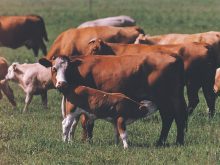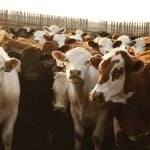There are many bulls out there “shooting blanks.”
Researchers came to this conclusion after assessing bulls using a breeding soundness evaluation. Of those tested, 25 percent failed to meet fertility standards. These bulls are a problem because they reduce conception rates, which in turn lower profits.
A breeding soundness evaluation is a quick and economical way to screen bulls for potential fertility. The evaluation has three steps. The first is a physical examination of the bull’s entire body with particular focus on the reproductive tract. This includes a thorough orthopedic assessment, checking for conditions that affect its ability to travel on pasture or to mount and breed cows.
Read Also

Dry summer conditions can lead to poor water quality for livestock
Drought conditions in the Prairies has led to an decrease in water quality, and producers are being advised to closely monitor water quality for their animals.
In some cases, the examination also includes screening for specific diseases. For example, bulls used on community pastures may be checked for venereally transmitted infections like trichomoniasis.
The second step is measuring the bull’s scrotal circumference. This measurement is correlated to testicular weight, which reflects daily sperm production and semen quality.
According to the Society of Theriogenology, the minimum scrotal circumference for a bull under 15 months old is 30 centimetres while a bull older than 24 months should have a scrotal circumference more than 34 cm. Suboptimal fertility is expected from bulls that do not meet these standards.
The last step, collection and evaluation of a semen sample, provides information about the bull’s semen and sperm cells, or spermatozoa. The bull’s semen volume is measured and the sperm cells are counted. From this, the total number of sperm in the ejaculate is calculated. This count is especially important for the fate of bulls at artificial insemination centres. The total number of sperm determines how many doses of semen can be packaged from one ejaculate.
Sperm cells are analyzed to determine if they are normal. Abnormal spermatozoa have small or giant heads, tails that are coiled or folded, or they have droplets attached to their tail sections. To pass evaluation, at least 70 percent of a bull’s sperm cells must be normal in appearance.
Spermatozoa are also checked for motility – the capacity to propel forward. This is important because sperm need to swim directly through the female reproductive tract to reach and fertilize eggs. Although 30 percent motility is considered fair and passable, a bull with a higher percentage of forward-moving spermatozoa will have better fertility.
Once all this data is collected, a bull can be labelled as either a satisfactory or an unsatisfactory potential breeder. If satisfactory, it is free of genetic, skeletal or infectious conditions that could compromise fertility. It also means the bull has achieved minimum levels for scrotal circumference and its sperm cells have normal anatomy and motility.
Occasionally, a bull will be given a deferred classification. In this case, it has failed one section of the evaluation but the tester believes it is likely to improve with time or treatment. The bull should be retested in the future before judgment is passed.
One of the most common reasons for a deferred rating is immaturity, but most younger bulls go on to productive breeding careers after passing a second soundness evaluation.
















